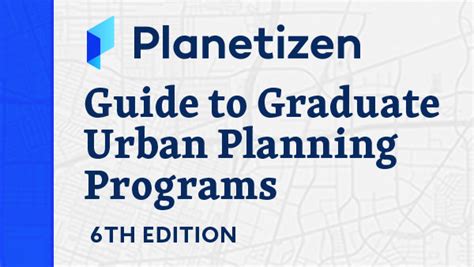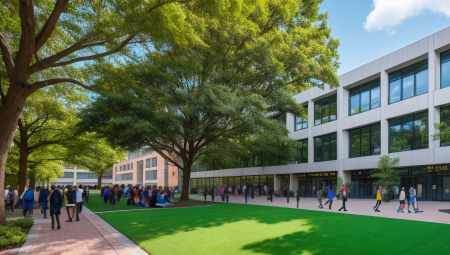In recent years, the concept of sustainable community development has gained significant attention as cities and urban areas grapple with issues such as climate change, social inequity, and affordable housing. As a result, urban studies and planning programs in top US universities have become increasingly important in shaping the future of our cities. In this blog post, we will explore the role of urban studies and planning programs in building sustainable communities, as well as the specific curriculum and initiatives offered by these programs. From understanding sustainable community development to promoting social equity and incorporating renewable energy, these programs play a crucial role in addressing the complex challenges facing modern cities. We will also delve into the collaboration between universities and local governments, as well as the importance of engaging communities in sustainable development initiatives. Join us as we take a closer look at how these programs are shaping the urban landscape and fostering resilience in the face of a changing climate.
Table of Contents
Understanding Sustainable Community Development
Understanding sustainable community development requires a comprehensive approach that takes into account the social, economic, and environmental factors that contribute to the well-being of a community. It involves creating and implementing strategies that promote long-term sustainability, resilience, and equity within the community.
When it comes to sustainability, it is important to consider the ways in which development can meet the needs of the present without compromising the ability of future generations to meet their own needs. This includes addressing issues such as resource depletion, pollution, and social inequalities.
Community development should also be approached holistically, taking into account the unique characteristics and challenges of each community. This may involve engaging with local residents, businesses, and organizations to identify their needs and priorities, as well as considering the environmental and cultural context of the area.
Ultimately, the goal of sustainable community development is to create thriving, livable communities that are inclusive, resilient, and environmentally responsible. It requires collaboration and cooperation between various stakeholders, including local governments, non-profit organizations, and private sector entities.
The Role of Urban Studies and Planning Programs
Urban studies and planning programs play a crucial role in shaping the future of cities and communities. These programs offer a comprehensive understanding of urban development, design, and policy, equipping students with the knowledge and skills needed to address complex urban challenges.
One of the main roles of urban studies and planning programs is to train future urban planners and professionals who can contribute to sustainable development. Through coursework, hands-on projects, and internships, students gain practical experience in conducting research, analyzing data, and developing strategies for urban growth and revitalization.
Moreover, these programs also serve as platforms for research and innovation in urban planning. Faculty members and students engage in interdisciplinary studies, exploring new approaches to urban design, environmental sustainability, and community engagement. By collaborating with local governments, non-profit organizations, and industry partners, urban studies and planning programs become hubs of knowledge exchange and experimentation.
Ultimately, the role of urban studies and planning programs extends beyond academic pursuits. These programs have the potential to shape public policy, influence urban development projects, and advocate for inclusive and equitable cities. By training the next generation of urban leaders, these programs actively contribute to the positive transformation of our urban landscapes.
Curriculum Overview: Urban Planning and Design
Urban planning and design are essential components of sustainable community development. The curriculum for urban planning and design programs typically includes a comprehensive overview of urban theories, principles, and practices. Students study the historical evolution of urban areas, analyze current urban challenges, and explore innovative solutions for sustainable urban development.
The curriculum also encompasses courses on land use planning, transportation systems, environmental design, and community development. Students acquire knowledge about zoning regulations, urban infrastructure, and public policy that shapes urban landscapes. Through practical projects and internships, students gain hands-on experience in designing and implementing sustainable urban projects.
Furthermore, the curriculum emphasizes the integration of social equity, environmental sustainability, and economic viability in urban development. Students learn about the importance of community engagement, participatory planning processes, and inclusive design practices to create livable and resilient urban environments.
Overall, the curriculum for urban planning and design programs equips students with the skills, knowledge, and critical thinking abilities necessary to address complex urban challenges and contribute to the creation of vibrant, inclusive, and sustainable communities.
Exploring Sustainable Infrastructure and Transportation
In today’s rapidly growing cities, sustainable infrastructure and transportation have become top priorities for urban planners and developers. The need for efficient and environmentally friendly systems is essential in creating livable and resilient communities.
When it comes to infrastructure, a sustainable approach involves incorporating green technologies and materials, as well as designing for longevity and adaptability. This includes implementing green building practices, utilizing renewable energy sources, and promoting water and energy efficiency. By prioritizing sustainability in infrastructure projects, cities can minimize their environmental impact and reduce their carbon footprint.
Similarly, sustainable transportation aims to reduce reliance on single-occupancy vehicles and promote alternative modes such as public transit, walking, and cycling. This not only reduces congestion and air pollution but also improves public health and well-being. In addition, integrating smart technologies and innovative design elements into transportation systems can further enhance efficiency and sustainability.
Overall, exploring sustainable infrastructure and transportation is crucial in shaping the future of our cities. By embracing sustainable practices and technologies, urban areas can become more resilient, livable, and environmentally friendly for current and future generations.
Promoting Social Equity in Urban Development
When it comes to promoting social equity in urban development, there are a number of important factors that must be considered. One of the most critical of these is the need to ensure that all members of a community have equal access to resources and opportunities. This means that urban planners and developers must be mindful of the potential impacts of their projects on different demographic groups, and take steps to mitigate any negative effects. For example, this might involve implementing policies to prevent gentrification and displacement of long-time residents, or investing in affordable housing options.
Another key consideration in promoting social equity in urban development is the need to ensure that public spaces and municipal services are accessible to all members of the community. This includes things like parks, libraries, public transportation, and healthcare facilities. If these resources are concentrated in wealthier areas and are not accessible to those in low-income neighborhoods, it can perpetuate inequality and exclusion. Therefore, urban planners must work to ensure that these resources are distributed in an equitable manner.
In addition to these considerations, promoting social equity in urban development also involves thinking about the long-term impacts of development projects on the community. This means not only looking at the immediate effects of a project, but also considering how it will shape the social and economic dynamics of the area over time. For example, a new mixed-use development might attract new residents and businesses to an area, but what will be the consequences for those who are already living and working there? Will the project exacerbate existing inequalities, or will it help to create a more inclusive and diverse community?
In conclusion, promoting social equity in urban development requires careful consideration of a range of factors, from the distribution of resources and services, to the long-term impacts of development projects on the community. By taking these considerations into account, urban planners and developers can work to create more equitable, inclusive, and sustainable cities and communities.
Sustainable Housing and Affordable Living Solutions
When it comes to sustainable housing and affordable living solutions, it is important to consider the environmental impact of the housing options available. Many people are unaware of the resources that go into housing construction, and how it affects the environment. By prioritizing sustainable housing, we can create living spaces that are not only better for the planet, but also more affordable for residents in the long run.
One way to achieve sustainable housing is through the use of renewable building materials. This can include materials such as bamboo, cork, and reclaimed wood, which are all sustainable options that have a lower impact on the environment compared to traditional materials. Additionally, incorporating energy-efficient designs and technologies can also reduce the environmental footprint of housing while simultaneously lowering energy costs for residents.
In order to ensure affordable living solutions, it is important to consider the location of housing developments. By focusing on urban infill and revitalizing existing communities, we can provide affordable housing options that are close to amenities and transportation, reducing the need for long commutes. This not only saves residents money on transportation costs, but it also creates a more sustainable and connected community.
Ultimately, by prioritizing sustainable housing and affordable living solutions, we can create communities that are not only better for the environment, but also more accessible and affordable for residents. Through the use of renewable materials, energy-efficient technologies, and thoughtful community planning, we can create a more sustainable and equitable future for all.
Incorporating Renewable Energy in Community Planning
Renewable energy is becoming an increasingly important consideration in community planning. With the global push for sustainability and environmental consciousness, many urban planners and developers are looking for ways to incorporate renewable energy sources into their community designs.
Including solar power and wind energy into community planning can not only reduce the environmental impact of a development but also provide long-term cost savings for residents and businesses. By integrating these renewable energy sources, communities can decrease their reliance on non-renewable resources and reduce greenhouse gas emissions.
When it comes to renewable energy in community planning, it’s important for urban planners to consider the potential for microgrids and battery storage systems. These technologies can help communities store and distribute energy more efficiently, leading to greater reliability and resilience in the face of power outages or disruptions.
Community planning that successfully incorporates renewable energy can serve as a model for sustainable development, inspiring other regions to embrace green technologies and make positive contributions to global efforts to combat climate change.
Engaging Communities in Sustainable Development Initiatives
Engaging communities in sustainable development initiatives is a crucial aspect of creating lasting change and positive impact in urban areas. When communities are involved in the decision-making process and have a say in the development of their neighborhoods, there is a greater chance of success and long-term sustainability.
One way to engage communities in sustainable development initiatives is to organize community workshops and forums where residents can voice their concerns and ideas for the future of their neighborhoods. This allows for open communication and collaboration between residents and urban planners, leading to the creation of development plans that truly reflect the needs and desires of the community.
Another effective method of engaging communities in sustainable development initiatives is through education and awareness campaigns. By providing residents with information on sustainable practices and the benefits of environmentally friendly development, communities can be empowered to take an active role in promoting sustainable living within their neighborhoods.
Furthermore, community-led initiatives such as neighborhood clean-up days, tree planting events, and sustainable gardening projects can help foster a sense of ownership and pride within the community. When residents are actively involved in the improvement and maintenance of their neighborhood, they are more likely to support and participate in sustainable development initiatives.
Studying Urban Resilience in the Face of Climate Change
Urban resilience in the face of climate change is an increasingly important topic as cities around the world are experiencing the impacts of extreme weather events and rising sea levels. Studying urban resilience involves understanding how cities can adapt and bounce back from these challenges, while also working to mitigate the causes of climate change.
One key aspect of urban resilience is the ability to develop sustainable infrastructure and transportation systems that can withstand the impacts of climate change. This includes not only building stronger and more resilient infrastructure, but also implementing transportation solutions that are less carbon-intensive and more adaptable to changing conditions.
Another important area of focus is the promotion of social equity in urban development. This means ensuring that all members of the community, regardless of income or background, have equal access to resources and opportunities to adapt to and mitigate the effects of climate change.
In addition, studying urban resilience involves exploring sustainable housing and affordable living solutions. This includes the development of energy-efficient and climate-resilient affordable housing, as well as policies that promote sustainable living practices for all residents.
Collaboration between Universities and Local Governments
When it comes to sustainable community development, collaboration between universities and local governments can play a crucial role in driving positive change. By working together, these two entities can leverage their unique strengths to tackle complex challenges and drive innovative solutions.
Universities bring a wealth of knowledge, research capabilities, and academic expertise to the table. Through their research programs, faculty, and students, universities can provide valuable insights and data-driven analysis to help local governments make informed decisions about urban planning, transportation, energy, and social equity.
On the other hand, local governments have the power to implement policies, regulations, and infrastructure projects that can directly impact the quality of life for residents. By partnering with universities, local governments can tap into cutting-edge research, best practices, and expert guidance to inform their decision-making processes and ensure that their initiatives are sustainable, equitable, and effective.
Ultimately, collaboration between universities and local governments can lead to more holistic and impactful approaches to community development. By bridging the gap between theory and practice, research and implementation, these partnerships can drive positive change and create more sustainable, resilient, and inclusive communities for the future.





